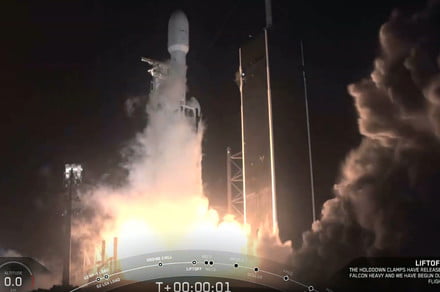[youtube https://www.youtube.com/watch?v=WxH4CAlhtiQ?feature=oembed&w=100&h=100]
SpaceX’s Falcon Heavy rocket lit up the Florida sky early Tuesday local time as it roared into space at the beginning of a six-hour mission described by CEO Elon Musk as the company’s “most difficult launch ever.”
The challenge comes from the sheer scale of the endeavor, with its large payload requiring 4 upper stage engine burns for the launch of 24 satellites, with 20 distinct separation events taking place during 3 separate orbits.
There was also the matter of bringing the Heavy’s three first-stage rockets back to Earth in one piece. But this particular feat proved too tricky for the core booster, which crashed into the sea after narrowly missing its landing target on the drone ship, though happily for SpaceX the two side boosters were able to return safely to Cape Canaveral.
The world’s most powerful operational rocket lifted off at 2.30 a.m. E.T. from Launch Complex 39A at the Kennedy Space Center in Florida in what was the third launch for the massive rocket — with the two side boosters being re-used for the first time — since its debut outing in February 2018.
Think of the Falcon Heavy as a larger version of SpaceX’s more established Falcon 9 rocket. With 5 million pounds of thrust at liftoff — equal to approximately eighteen 747 aircraft — the Heavy is able to carry into orbit a weight equal to almost 64 metric tons (141,000 pounds), or, as SpaceX describes it, “a mass greater than a 737 jetliner loaded with passengers, crew, luggage, and fuel.”
This latest mission, named Space Test Program 2 (STP-2), is SpaceX’s first for the U.S. Department of Defense (DoD), and carries with it a wide-ranging payload for a total of 13 partners.
It includes solar-sail technology promoted by science celebrity Bill Nye, a satellite designed to test a new type of eco-friendly fuel propellant for NASA, and a Deep Space Atomic Clock, also from NASA, that could one day assist spacecraft in future missions to more far-flung places.
Twelve nanosatellites will also be deployed. Built by students from Michigan Technological University, the devices will be used to help ground-based observatories monitor orbiting spacecraft more efficiently.
In addition, the payload includes an experiment for studying space radiation to find out how it affects spacecraft and electronics in orbit.
The mission will also see the cremated remains of 152 people, among them Apollo 11 support astronaut Bill Pogue, delivered into space as part of a service offered by space-funeral firm Celestis. Each set of remains is placed in its own canister, which orbits Earth before vaporizing like a shooting star as it re-enters the atmosphere.
You can find out more about the contents of the Falcon Heavy’s payload on NASA’s Tumblr site.
The early indications are that SpaceX’s most ambitious outing to date is proceeding mostly as planned, though it still has a number of stages to complete before the deployment part of the mission can be deemed a success.
Editors’ Recommendations
- How to watch SpaceX’s most difficult Falcon Heavy launch ever
- SpaceX joins internet-from-space race with launch of 60 Starlink satellites
- Mission success! SpaceX delivers satellite, lands all 3 Falcon Heavy boosters
- SpaceX launch to resupply ISS finally goes off after several delays
- SpaceX’s main Falcon Heavy booster is lost at sea after falling off drone ship

